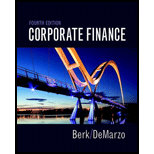
Corporate Finance (4th Edition) (Pearson Series in Finance) - Standalone book
4th Edition
ISBN: 9780134083278
Author: Jonathan Berk, Peter DeMarzo
Publisher: PEARSON
expand_more
expand_more
format_list_bulleted
Question
Chapter 29, Problem 9P
Summary Introduction
To discuss: The pros and cons for raising the options granted to the Chief Executive officers (CEOs).
Introduction:
The company’s compensation policies provide the managers an ownership stake by taking the grants of stock or stock options to the executive of the company. These grants provide the direct incentive to managers for raising the stock price mainly to make the company’s stock or stock option more valuable. As a result, the stock and option grants naturally tie managerial wealth to the wealth of shareholders.
The monetary and non-monetary benefits paid to the employs by the employer for the work done are termed as compensation.
Expert Solution & Answer
Want to see the full answer?
Check out a sample textbook solution
Students have asked these similar questions
What is the difference between a contra asset account and a liability?i need help.
What is the significance of a company’s price-to-earnings (P/E) ratio? i need answer.
What is the significance of a company’s price-to-earnings (P/E) ratio?
Chapter 29 Solutions
Corporate Finance (4th Edition) (Pearson Series in Finance) - Standalone book
Ch. 29.1 - Prob. 1CCCh. 29.1 - Prob. 2CCCh. 29.2 - Prob. 1CCCh. 29.2 - Prob. 2CCCh. 29.3 - What is the main reason for tying managers...Ch. 29.3 - Prob. 2CCCh. 29.4 - Prob. 1CCCh. 29.4 - Prob. 2CCCh. 29.5 - Prob. 1CCCh. 29.5 - Prob. 2CC
Ch. 29.5 - Prob. 3CCCh. 29.6 - Prob. 1CCCh. 29.6 - Prob. 2CCCh. 29 - Prob. 1PCh. 29 - Prob. 2PCh. 29 - Prob. 3PCh. 29 - Prob. 4PCh. 29 - Prob. 5PCh. 29 - Prob. 6PCh. 29 - Prob. 7PCh. 29 - Prob. 8PCh. 29 - Prob. 9PCh. 29 - Prob. 10PCh. 29 - Prob. 11PCh. 29 - Prob. 12PCh. 29 - Prob. 13PCh. 29 - Prob. 14PCh. 29 - Prob. 15PCh. 29 - Prob. 16PCh. 29 - Prob. 17PCh. 29 - Prob. 18PCh. 29 - Prob. 19PCh. 29 - Prob. 20P
Knowledge Booster
Similar questions
arrow_back_ios
SEE MORE QUESTIONS
arrow_forward_ios
Recommended textbooks for you
 EBK CONTEMPORARY FINANCIAL MANAGEMENTFinanceISBN:9781337514835Author:MOYERPublisher:CENGAGE LEARNING - CONSIGNMENTBusiness/Professional Ethics Directors/Executives...AccountingISBN:9781337485913Author:BROOKSPublisher:Cengage
EBK CONTEMPORARY FINANCIAL MANAGEMENTFinanceISBN:9781337514835Author:MOYERPublisher:CENGAGE LEARNING - CONSIGNMENTBusiness/Professional Ethics Directors/Executives...AccountingISBN:9781337485913Author:BROOKSPublisher:Cengage
 Intermediate Financial Management (MindTap Course...FinanceISBN:9781337395083Author:Eugene F. Brigham, Phillip R. DavesPublisher:Cengage Learning
Intermediate Financial Management (MindTap Course...FinanceISBN:9781337395083Author:Eugene F. Brigham, Phillip R. DavesPublisher:Cengage Learning

EBK CONTEMPORARY FINANCIAL MANAGEMENT
Finance
ISBN:9781337514835
Author:MOYER
Publisher:CENGAGE LEARNING - CONSIGNMENT

Business/Professional Ethics Directors/Executives...
Accounting
ISBN:9781337485913
Author:BROOKS
Publisher:Cengage


Intermediate Financial Management (MindTap Course...
Finance
ISBN:9781337395083
Author:Eugene F. Brigham, Phillip R. Daves
Publisher:Cengage Learning

